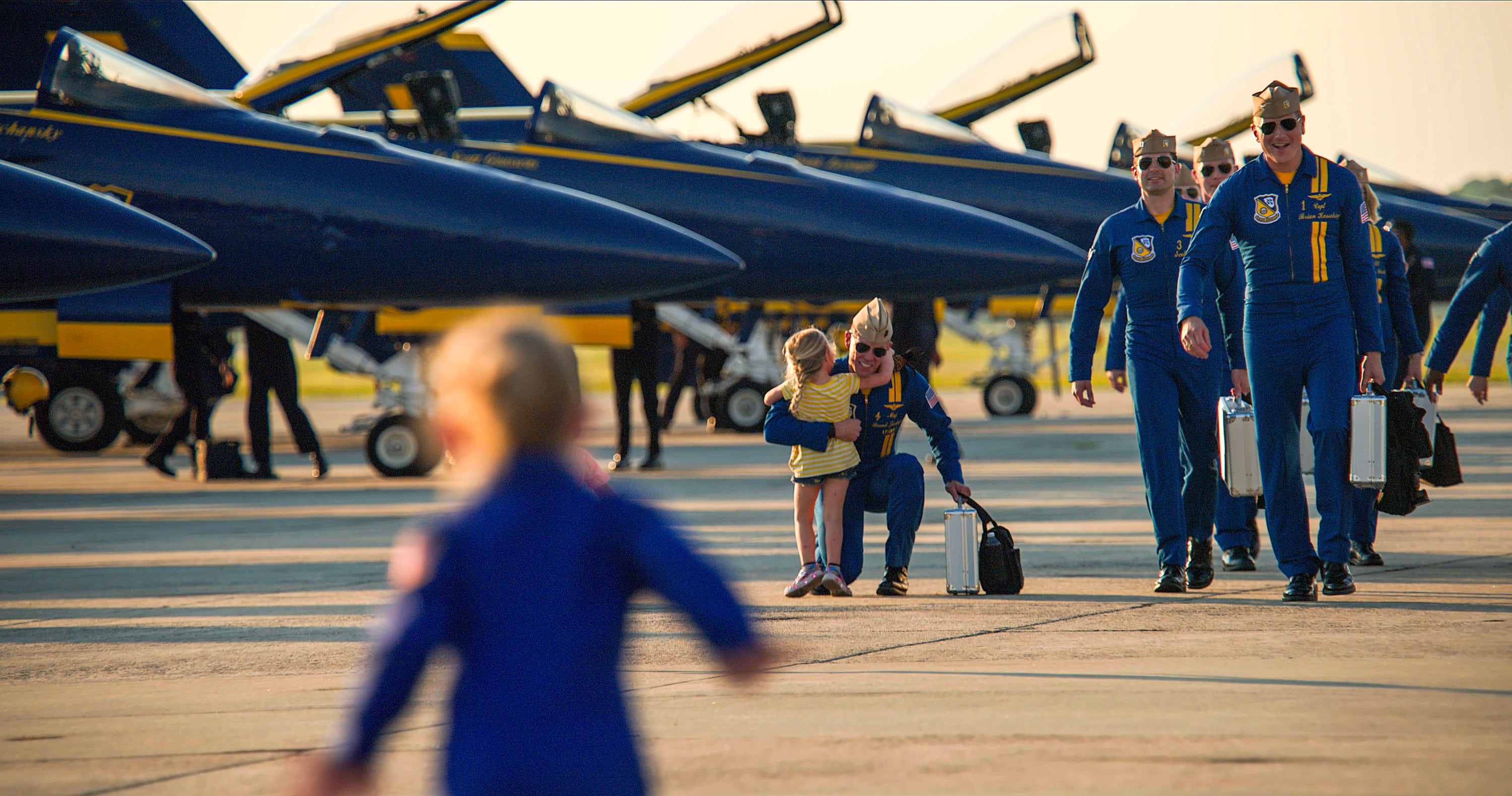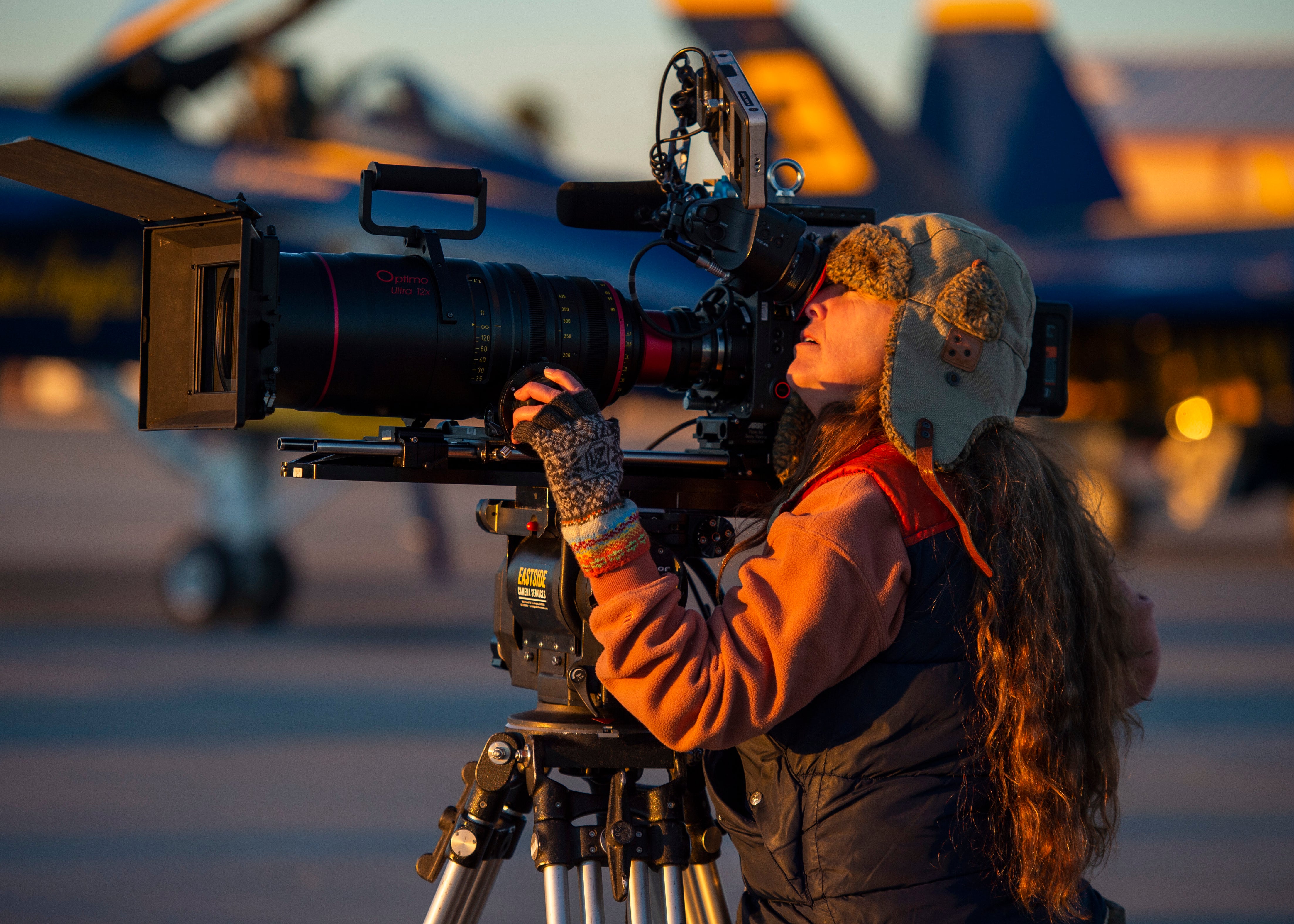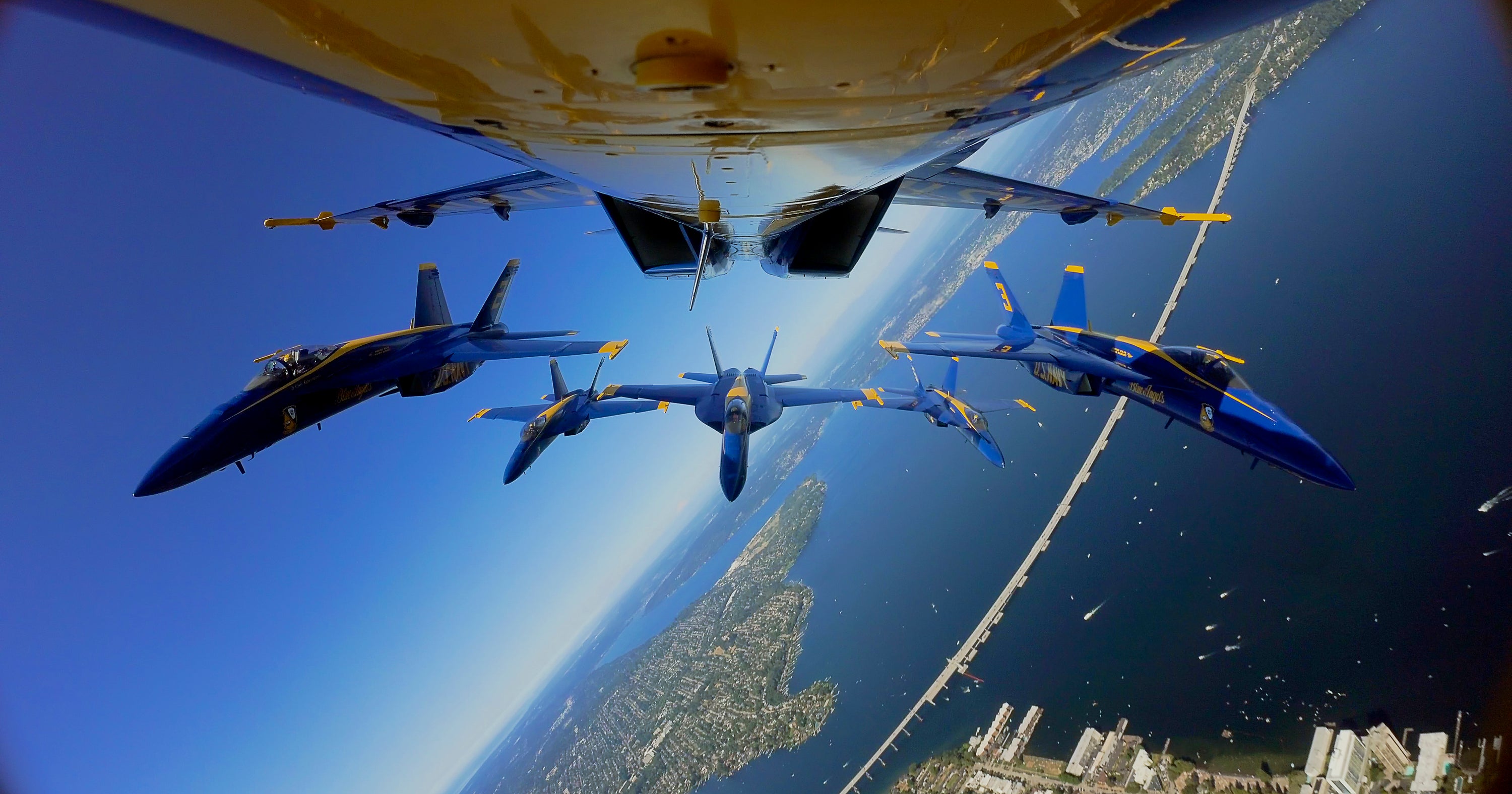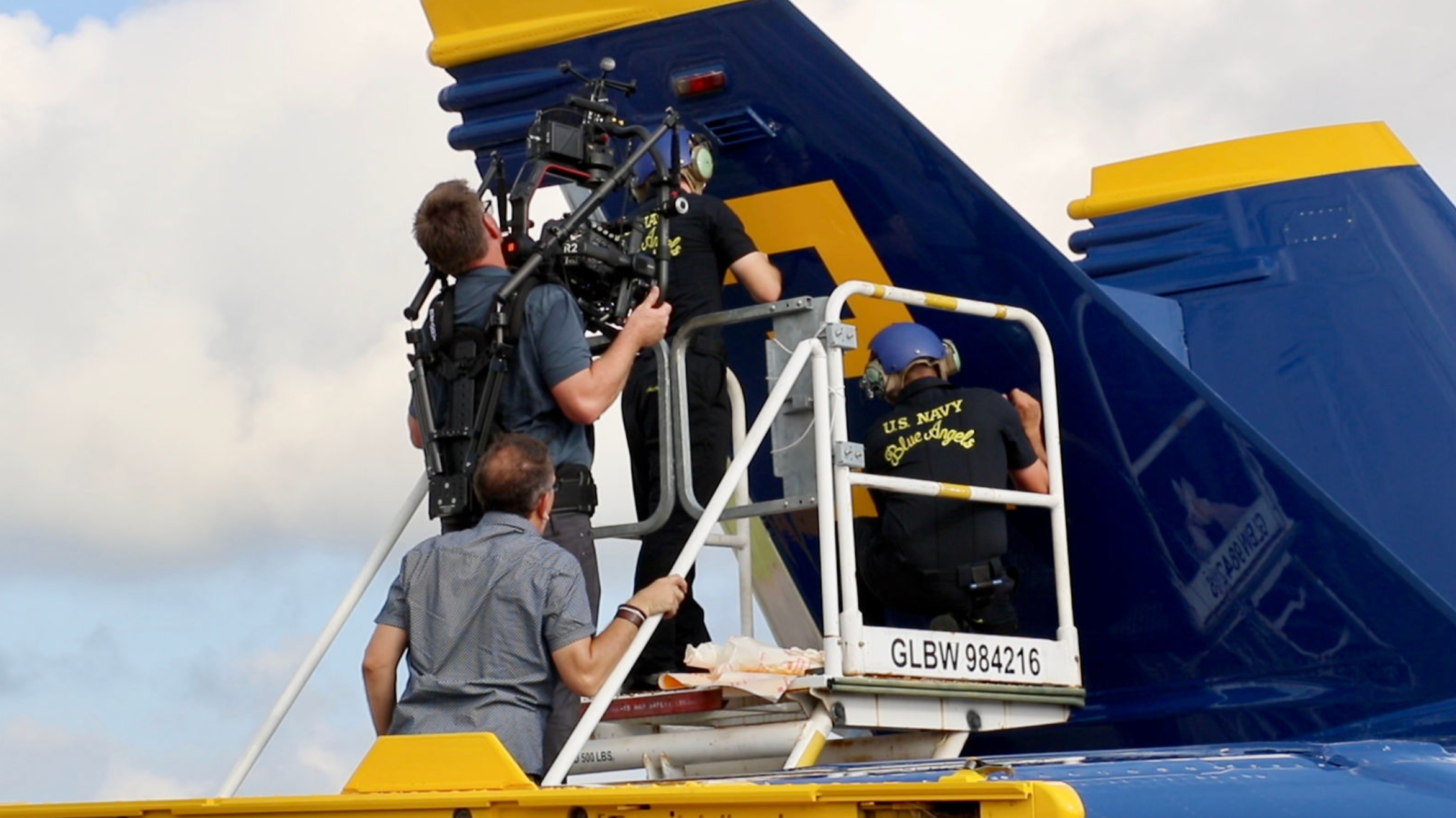
05-26-2024 - Case Study
Behind the Scenes of 'The Blue Angels' documentary
By: Jessica Young, Special Guest
Director of Photography Jessica Young gives us a first-hand account of creating the film
“From the Cockpit,” it read in the headline when this project was announced in early 2022. The challenge of getting cameras into the cockpit of The Blue Angels F-18’s was already well on my mind throughout pre-production - now given that headline, we had to deliver.
At that time, the anticipation of the theatrical release of “Top Gun: Maverick” was palpable. The trailer was playing on repeat. I reached out to Danny Ming, Lead AC on Maverick and he graciously talked me through the painstaking details it took to capture the multi-cam dynamic action of the actors in flight. I quickly realized however, their same amount of research and development and access to F-18’s was unfortunately, not going to be at our disposal.
We were going to need to find another way to tell this story.
Our “actors” were the actual pilots doing the actual flying. We couldn’t film the Blue Angels in flight unless it was part of their regular scheduled practice demo or show performance. They would be flying single seat aircraft. We would be getting no direct access to their jets for testing mounts, and we could not ask for a take two.
Producers Boss Greg Wooldridge and Rob Stone had started a conversation with Glen Powell that had led to JJ Abrams and IMAX, and ultimately Amazon Prime. I came along in January 2022. Director Paul Crowder reached out in a phone lengths text message that described the most grand idea I ever heard. A few days later, on a scout in El Centro, CA - that moment when the Blue Angel formation flew right over my head with a power I had never felt before - I was hooked.
Choosing the Sony VENICE camera system was an easy decision. We could explain to the Navy that the cameras would be the same used on Top Gun: Maverick and IMAX was happy with the 6K resolution.
I knew we would need coverage from all sides - ground to air, air to air, attached to the exterior of the jets, and of course, from inside the cockpit.
The good news was that the Top Gun: Maverick aerial team was already on-board!

DP Jessica Young on set with the Sony VENICE
Filming Air to Air
Coming off films Top Gun: Maverick and Devotion, Kevin LaRosa II served as Aerial Coordinator and Helicopter Pilot for the production. He and Aerial Director of Photography Michael FitzMaurice worked closely with the Blues over many months and meetings to achieve the safest procedures for shooting the most dynamic aerial shots of the film. A civilian helicopter was given permission to fly inside the Blue Angel air box for the first time in history.
The Sony VENICE 2 camera was flown on the helicopter’s Shotover G1 stabilized remote head, great for heavy weight payloads. The VENICE 2 was paired with the Angenieux 24-290mm lens + 1.4 expander.
Also on-board the helicopter was Lance “Bubbs” Benson, a former Blue Angel pilot. He helped navigate the helicopter into the safest positions and maintained communications with the jet pilots. He knew each nuance of the flight demo and had their full trust.
After several successful flights with the team in Pensacola - we decided to take it up a notch - shoot the demo with a Phantom Camera at 1000fps! The science of water vapor against the force of extreme speed is a sight to behold.

The Cockpit Cameras
After testing all kinds of small gadget cameras and putting the footage up on the IMAX screens, we landed on the Insta360 One RS. Small enough to fit in the palm of your hand, the lens was made with Leica and offered the ability to add glass ND filters. Controlling the shutter speed I believe was key in matching the cockpit footage to all the other cinema cameras. The One RS recorded 5.3K 16:9 and we used the camera’s LOG setting.
Remarkably, we did not need to add the stabilization “flowstate” option, which crops the image. The only friction in-air comes during intense G-Force maneuvers, take-offs and landings. The in-camera vibration that is visible during those moments lends some energy to those actions. We were able to maintain the highest resolution possible and we flew the cameras regularly.
The exchange had to be fool proof. The One RS cameras, 5-6 of them lined up on any given day, standing at attention with heavy duty suction mounts and instructions for which aircraft they would fly in and a suggestion of the camera placement.
The pilots would exit their morning debrief, check out the cameras to understand the assignment, the units would be handed off to the pilots respective Crew Chief, and then show up into their jet prior to the demo. The pilots were responsible for mounting the cameras into their canopy pre-flight.
We also successfully flew the Insta360 One RS 1-inch 360. The stitched shots allowed for panning around inside the cockpit. This introduced a whole new view and was a great way to achieve a very wide angle inside such a small space.
The Exterior Mounts
For the production, the Navy machined a custom housing for the InstaMax One RS - called the “lookback” or “chin” mount. It lived on the exterior belly of the #1 jet in the formation. We flew it in every city and every flight demo possible.
After months of hunting we finally tracked down the custom camera housings that flew on the exterior wings of the F-18 in Top Gun: Maverick. We gave the Navy-built housings back over to the Navy, and they were put through the paces of rigorous testing to once again, prove air-worthiness. They replaced every screen and screw, but otherwise all 3 housings were intact.
The housings held the original VENICE’s stripped down to their E-Mount lens mount and SxS media recorders. Custom dual battery mounts crafted by Keslow’s R&D team powered the set-up. Each camera wore a 12mm Voigtlander lens that was deconstructed and custom fit. We could fly 3 of these housings at one time on Navy mounted pylons usually designed to hold weaponry on the F-18 aircraft.
Picking the angle of view was less about seeing these jets in a dogfight as in Maverick, and more about using the chase jet air-to-air similar to how one might plan a car-to-car sequence.
The chase jet was an actual Blue Angel painted jet piloted by Benson. The camera and lens placement under the wing was fixed, so we talked a great deal about Benson’s field of view and strategy for covering the different Diamond and the Solo manuevers. Finally, the cinema camera was going as fast as the jets go!
For one demo, approved by #1 pilot Captain Brian Kesselring aka “Boss” - a Navy mounted keel mount was attached to his jet and he flew the VENICE pointing back at the formation.
Many hours of planning to achieve mere seconds of screen time, but again, this story needed to be told from all sides. All the angles edited together create the well-rounded flight sequences seen in the documentary.

Filming from the Ground
Full Frame Angenieux zoom lenses were the work horses of the film, EZ 1 & 2 and the 12:1 zooms Optimo 36-435mm and Optimo 24-290mm + expander. Each with Preston micro force zoom control. Arri Signature primes were used for interviews and some docu-scene work.
Handheld camera work was utilized “off-base” at Blue Angel team members homes or while filming personal life. Once they set foot “on-base” we used the camera on a gimbal MoVI Pro or Ronin II, or tripod. Gimbal Ops were mainly Josh Park and FitzMaurice.
We traveled with the team to several cities on the tour, Seattle, Chicago, San Francisco, Kaneohe Bay in Hawaii, Virginia Beach, Baltimore, and Miramar. The crew spent much time in Pensacola, FL where the Blue Angel team is based, and in El Centro, CA where they train in winter.
Each city visited required intense mapping and scouting to find the best placements for our multi-camera coverage. Permissions had to be given whether camera crews were with comm cart, at center point, or atop a skyscraper, bell tower or light house.
Any given day there was a myriad of Sony cameras and cinema lenses that needed assignments, and I would delegate the pairing of those tools into the hands of the Operators available. Lead AC, Wade Young and AC Case Norton would pull focus with Arri WCU 4 systems during most flight demos, training exercises and scene work. Director Paul Crowder and Producer Bridget Topp watched with the Teradek 3000 XT wireless video systems feeding our Small HD monitors. Eartec hands-free comms were worn by crew whenever possible.
Sean Stout and Maren Domalski of Sutter Road Pictures and Glen Zipper from Zipper Bros Productions championed the production. Lensea Films in Pensacola provided fantastic crew support.
The 140+ team members of The Blue Angels squad handled our needs and endless requests with grace. We were privileged to witness a year in their life.




